Digital Posters
Molecular Imaging & X-Nuclei: Applications
ISMRM & SMRT Annual Meeting • 15-20 May 2021

| Concurrent 2 | 13:00 - 14:00 |
 |
1784.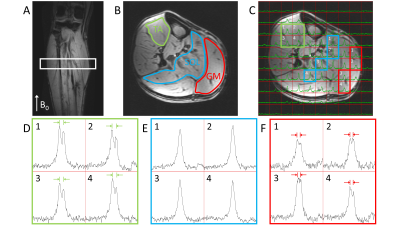 |
Quadrupole moment splittings observed in 7T deuterium magnetic resonance spectra of skeletal muscle
Ayhan Gursan1, Martijn Froeling1, Arjan D. Hendriks1, Dimitri Welting1, Dennis W.J. Klomp1, and Jeanine J. Prompers1
1Department of Radiology, University Medical Center Utrecht, Utrecht, Netherlands
DMI in combination with oral administration of deuterated glucose could potentially be used to investigate glycolytic and oxidative glucose metabolism in skeletal muscle non-invasively. However, skeletal muscle is a tissue with a high degree of spatial organization. In this study, we investigated the effect of anisotropic motional averaging on 7T deuterium spectra of the lower leg muscles. We observed quadrupole moment splittings of the natural abundance HDO signal and showed that the size of these splittings depends on the angle between muscle fibers and the main magnetic field B0.
|
||
1785.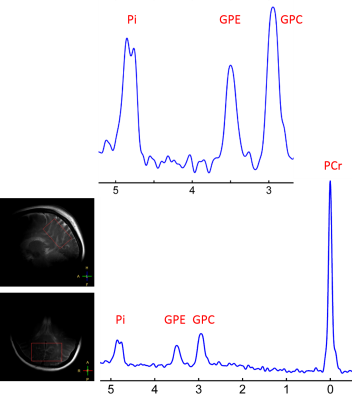 |
Brain Metabolic Heterogeneity Revealed by Inorganic Phosphate (Pi): The Puzzling Line Broadening and Splitting of Pi Magnetic Resonance at 7T
Jimin Ren1,2, Craig R Malloy1,2, and Dean Sherry1,2
1Advanced Imaging Research Center, UT Southwestern Medical Center, Dallas, TX, United States, 2Department of Radiology, UT Southwestern Medical Center, Dallas, TX, United States
Despite its very small size and highly structural symmetry, the brain inorganic phosphate (Pi) signal is twice broader in linewidth or even splitting as compared to phosphocreatine signal by 31P-MRS at 7T. This puzzling phenomenon is attributed to spacial pH heterogeneity and rapid Pi diffusion between different cellular compartments, which likely prevails over other potential factors such as chemical exchange. Importantly, the Pi lineshape deconvolution by a two-component approach may provide a novel way to measure the distribution of neurons and astrocytes in brain if the assignment confirmed. Therefore this simple method may hold great promise to study neurodegenerative diseases.
|
|||
1786.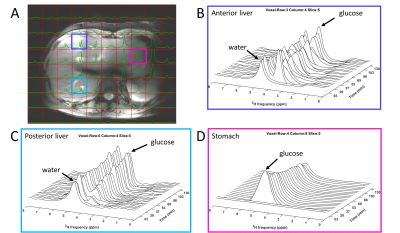 |
Monitoring liver glucose uptake and metabolism with dynamic 3D deuterium metabolic imaging at 7T
Ayhan Gursan1, Arjan D. Hendriks1, Dimitri Welting1, Dennis W.J. Klomp1, and Jeanine J. Prompers1
1Department of Radiology, University Medical Center Utrecht, Utrecht, Netherlands
Deuterium metabolic imaging (DMI) is an emerging method to assess metabolism in vivo. In this study, we applied dynamic 3D DMI with oral administration of deuterated glucose to investigate the dynamics of hepatic glucose uptake and metabolism at 7T. After glucose intake, the signal from deuterated glucose logarithmically increased in the liver and plateaued around 100 min, after which it decreased again, as a result of its conversion through glycolysis, oxidative metabolism and, probably the largest part, glycogen synthesis. DMI will be a valuable tool to study disturbances of liver metabolism in metabolic diseases.
|
|||
1787.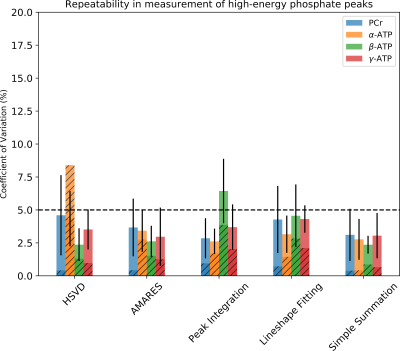 |
Precision and Reliability of Metabolite Quantification of 31P MRS at 7T
Jia Xu1, Rolf F. Schulte2, William R. Kearney1, and Vincent A. Magnotta1,3,4
1Radiology, University of Iowa, Iowa City, IA, United States, 2GE Global Research, Munich, Germany, 3Psychiatry, University of Iowa, Iowa City, IA, United States, 4Biomedical Engineering, University of Iowa, Iowa City, IA, United States
The test-retest repeatability of ATP and PCr concentrations in the human brain was measured with a non-localized, quantitative 31P MRS protocol. The performance of several automated MRS quantification methods that require little or no human intervention were evaluated. We found that the peak integration by simple summation of the magnitude spectrum is the most sensitive and robust to detect small ATP concentration changes. The excellent test-retest repeatability enables ATP concentration to be studied instead of using them as internal reference. This is important in diseases such as those that impair mitochondrial function resulting in impaired oxidative phosphorylation.
|
|||
1788.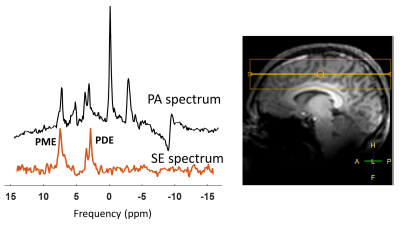 |
31P dual-band pulse for selective refocusing of phosphomonoesters and phosphodiesters at low B1+ and low SAR
Zahra Shams1, Evita C. Wiegers1, Wybe J.M. van der Kemp1, Dennis W.J. Klomp1, and Jannie P. Wijnen1
1Department of radiology, University Medical Center Utrecht, Utrecht, Netherlands
The ratio of phosphomonoesters (PME) and phosphodiesters (PDE) is potentially an important biomarker of cancer in the body, which can be measured by 31P MR spectroscopy. Here, we introduce a dual band pulse of low B1+ amplitude for specific refocusing of these metabolite signals. This can be an alternative solution to the high power demanding adiabatic refocusing pulses used for 31P MRS in the body, upon using a multi-echo sequence.
|
|||
1789.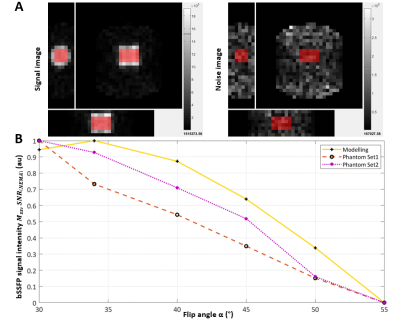 |
Multi-Centre patients receiving lithium treatment for bipolar disorder: 7Li-MRI optimization using a physiologically representative phantom
Karthik Chary1, Franck Mauconduit2, Fiona Smith1, Marie Chupin3, Emmanuelle Gourieux2,3, Laura Pelizzari4, Karen Kettless5, Kristoffer Brendstrup-Brix6, Eva Mezger7, Daniel Keeser7, Olaf Dietrich8, Tim Wesemann9, Philipp Ritter10,
Annett Werner9, Letizia Squarcina11, Paolo Brambilla11,12, Frank Bellivier13, Fawzi Boumezbeur2, David Cousins1,14, and Pete Thelwall1
1Translational and Clinical Research Institute, Newcastle Magnetic Resonance Centre, Newcastle University, Newcastle upon Tyne, United Kingdom, 2NeuroSpin, CEA, CNRS, Paris-Saclay University, Gif-sur-Yvette, France, 3CATI, Institut du Cerveau et de la Moëlle Epinière, Paris, France, 4IRCCS, Fondazione Don Carlo Gnocchi ONLUS, Milan, Italy, 5Siemens Healthcare A/S & Siemens Healthcare GmbH, Copenhagen, Denmark, 6Neurobiology Research Unit (NRU) at Copenhagen University Hospital Rigshospitalet, Copenhagen, Denmark, 7Department of Psychiatry and Psychotherapy, University Hospital, LMU University, Munich, Germany, 8Department of Radiology, University Hospital, LMU Munich, Munich, Germany, 9Institute and Clinic of Diagnostic and Interventional Neuroradiology, University Hospital, Carl Gustav Carus, Dresden, Germany, 10Department of Psychiatry, University Hospital Carl Gustav Carus, Technische Universität Dresden, Dresden, Germany, 11Department of Pathophysiology and Transplantation, University of Milan, Milan, Italy, 12Department of Neurosciences and Mental Health, Fondazione IRCCS Ca' Granda Ospedale Maggiore Policlinico, Milan, Italy, 13INSERM UMRS-1144, AP-HP, Saint-Louis - Lariboisière – F. Widal Hospitals, Paris, France, 14Regional Affective Disorders Service, Cumbria, Northumberland, Tyne and Wear NHS Foundation Trust, Newcastle Upon Tyne, United Kingdom
7Li-MRI is a unique technique to trace the brain lithium distribution, which may predict treatment response in bipolar disorder. The signal-to-noise ratio in balanced steady state free precession acquisition protocols (bSSFP) for 7Li-MRI can be efficiently optimized using physiologically representative phantoms. We sought to implement and validate a bSSFP protocol to maximize 7Li signal amplitude using theoretical modelling and phantom acquisitions, further validating the sequence across multiple centres, ensuring data harmonization. bSSFP signal modelling and phantom data demonstrated good agreement, with minimal inter-site variation in signal-to-noise confirming suitability for use in our multi-centre study of lithium response in bipolar disorder.
|
|||
1790.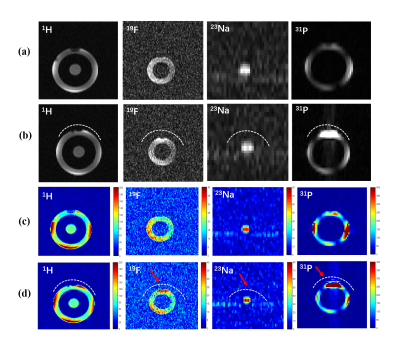 |
Simultaneous acquisition of 1H/19F/23Na/31P MR imaging in Phantom at 3T using a quadruple-nuclear RF coil system
Nan Li1,2, Xing Yang1,2, Feng Du1,2, Kang Yan3, Bei Liu3, Yiping Du3, Chunsheng Yang4,5, Zhi Zhang4,5, Li Chen4,5, Fang Chen4,5, Xiaoliang Zhang6, Xin Liu1,2, Hairong Zheng1,2, and Ye Li1,2
1Lauterbur Imaging Research Center, Shenzhen Institutes of Advanced Technology, Chinese Academy of Sciences, Shenzhen, China;, shenzhen, China, 2Key Laboratory for Magnetic Resonance and Multimodality Imaging of Guangdong Province, Shenzhen, China, Shenzhen, China, 3Institute for Medical Imaging Technology, School of Biomedical Engineering, Shanghai Jiao Tong University, Shanghai, China., Shanghai, China, 4State Key Laboratory of Magnetic Resonance and Atomic and Molecular Physics, Wuhan Center for Magnetic Resonance, Innovation Academy for Precision Measurement Science and Technology, the Chinese Academy of Sciences, Wuhan 430071, China;, Wuhan, China, 5University of Chinese Academy of Science, Beijing 100049, China, Wuhan, China, 6Department of Biomedical Engineering, State University of New York at Buffalo, NY, United States, Buffalo, NY, United States
Affected by the inherent physical properties, it was challenging to obtain the imaging of heteronuclear at 3T, which usually have weak MR signals. Hence, high performance was required of the RF system to excite and receive MR signals. In this study, a range of imaging tests were performed on the phantom by using the developed specific quadruple-nuclear RF coil system. The results demonstrated the feasibility of synchronized 1H/19F/ 23Na/31P MR imaging at 3T. Furthermore, the imaging approach combined the quadruple-nuclear RF coil and triple tuned local 19F/23Na/31P receive coil was also indicated the improved SNR of corresponding nucleus.
|
|||
1791.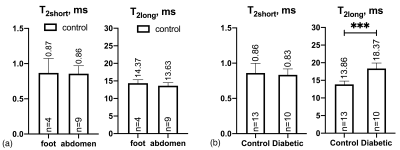 |
Sodium NMR relaxation times of human skin as potential biomarkers for Type 2 Diabetes Mellitus
Daria V Fomina1,2, Elnur G Sadykhov3, Petra Hanson4,5, Christopher J Philp1, Harpal S Randeva4,5, J Paul O'Hare4,5, Olga S Pavlova3,6, Nikolay V Anisimov6, Alexander M Makurenkov3, Yury A Pirogov3, Thomas M Barber4,5, Thomas Meersmann1, and Galina E Pavlovskaya1,2
1SPMIC, School of Medicine, University of Nottingham, Nottingham, United Kingdom, 2NIHR Nottingham Biomedical Research Centre, University of Nottingham, Nottingham, United Kingdom, 3Faculty of Physics, Lomonosov Moscow State University, Moscow, Russian Federation, 4Warwick Medical School, University of Warwick, Coventry, United Kingdom, 5Warwickshire Institute for the Study of Diabetes Endocrinology and Metabolism, University Hospitals Coventry and Warwickshire, Coventry, United Kingdom, 6Faculty of Fundamental Medicine, Lomonosov Moscow State University, Moscow, Russian Federation
Skin plays an important role in sodium regulation in the human body. As sodium interaction with macromolecules in biological tissue results in a bi-exponential T2 relaxation, a sensitive characterization of the molecular environment of the sodium ions can be made. This allows us to investigate sodium relaxation times, T2short and T2long, in human skin samples from patients with and without Type 2 Diabetes Mellitus (T2DM) using high-resolution 23Na MRS at high field 9.4T. We find that there is a significant elongation of T2long in T2DM patients. This might be indicative of disease specific skin structure changes.
|
|||
1792.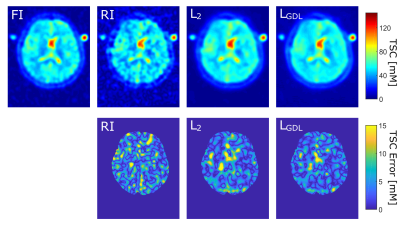 |
Accuracy of quantified 23Na MRI in ischemic Stroke with varying undersampling Factors and CNN Postprocessing
Anne Adlung1, Nadia Karina Paschke1, Alena-Kathrin Golla1,2, Dominik Bauer1,2, Sherif Mohamed3, Melina Samartzi4, Marc Fatar4, Eva Neumaier Probst3, Frank Gerrit Zöllner1,2, and Lothar Rudi Schad1
1Computer Assisted Clinical Medicine, Medical Faculty Mannheim, Heidelberg University, Mannheim, Germany, 2Mannheim Institute for Intelligent System in Medicine, Medical Faculty Mannheim, Heidelberg University, Mannheim, Germany, 3Department of Neuroradiology, Medical Faculty Mannheim, Heidelberg University, Mannheim, Germany, 4Department of Neurology, Medical Faculty Mannheim, Heidelberg University, Mannheim, Germany
This study investigates factors of k-space undersampling for which CNN postprocessing is able to improve 23Na MRI data. Data from 53 patients with ischemic stroke was included and image reconstruction was performed with full k-space data (FI) and with k-space data that was reduced (RI) by different factors (S = 2, 4, 5 and 10). Postprocessing with a convolutional neural network was applied to the highly undersampled 23Na MRI data. The CNN was able to significantly improve SNR and SSIM for all S with both loss functions. CNN postprocessing could enable significant reduction of 23Na MRI data acquisition time.
|
|||
1793.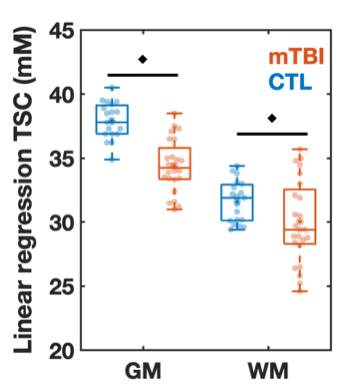 |
23Na MRI of mild traumatic brain injury: linear regression analysis reveals decreased total sodium concentration
TERESA GERHALTER1, Anna M. Chen1, Seena Dehkharghani1, Rosermary Peralta1, Fatemeh Adlparvar1, James S. Babb1, Tamara Bushnik2, Jonathan M. Silver3, Brian S. Im2, Stephen P. Wall4, Ryan Brown1, Guillaume Madelin1, and Ivan Kirov1
1Center for Biomedical Imaging, Department of Radiology, New York University Grossman School of Medicine, NEW YORK, NY, United States, 2Department of Rehabilitation Medicine, New York University Grossman School of Medicine, NEW YORK, NY, United States, 3Department of Psychiatry, New York University Grossman School of Medicine, NEW YORK, NY, United States, 4Ronald O. Perelman Department of Emergency Medicine, New York University Grossman School of Medicine, NEW YORK, NY, United States
In this quantitative sodium MRI study, 27 mild traumatic brain injury (mTBI) and 19 controls were scanned at 3 T. Linear regression analysis was used to measure total sodium concentrations (TSC) in global grey and white matter. We found statistically significant lower global grey and white matter TSC in mTBI patients compared to controls. This suggests that sodium imbalances in TBI, well-recognized from basic research, can be detectable non-invasively, are widespread over the entire brain, and are present even when the injury is clinically mild.
|
|||
1794.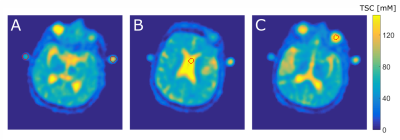 |
Evaluation of different References for the Quantification of Tissue Sodium Concentration in Patients with ischemic Stroke
Anne Adlung1, Sherif Mohamed2, Nadia Karina Paschke1, Mara Berger1, Melina Samartzi3, Marc Fatar3, Achim Gass4, Eva Neumaier Probst2, and Lothar Rudi Schad1
1Computer Assisted Clinical Medicine, Medical Faculty Mannheim, Heidelberg University, Mannheim, Germany, 2Department of Neuroradiology, Medical Faculty Mannheim, Heidelberg University, Mannheim, Germany, 3Department of Neurology, Medical Faculty Mannheim, Heidelberg University, Mannheim, Germany, 4Heidelberg University, Mannheim, Germany 23Na MRI is an indicator for cell viability and quantification provides the tissue sodium concentration (TSC). Aim of this study is to evaluate the reliability of cerebrospinal fluid (CSF) and vitreous humor (VH) as internal references for TSC quantification. Data of 49 patients with ischemic stroke was included for TSC quantification which was performed based on signal intensity within external references, CSF and VH. TSC of healthy tissue was significantly lower compared to pathological tissue. Results showed a high similarity between the three quantification methods. Internal references would simplify 23Na MRI measurements and thus its clinical establishment. |
|||
1795.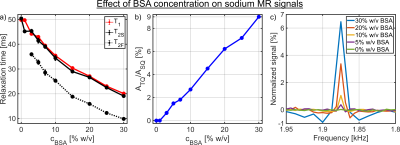 |
Sodium TQ signal of amino acids and α-lactalbumin in comparison to bovine serum albumin
Dennis Kleimaier1, Simon Reichert1, Victor Schepkin2, and Lothar R. Schad1
1Computer Assisted Clinical Medicine, Heidelberg University, Mannheim, Germany, 2National High Magnetic Field Laboratory, Florida State University, Tallahassee, FL, United States
This study demonstrates that amino acids and the protein α-LA do not yield a sodium TQ signal. Despite a significant reduction in sodium relaxation times, a sodium TQ signal was not observed for the amino acids glutamic acid, arginine, and lysine, as well as for the small sized protein α-LA up to their highest concentration dissolvable in water. In contrast, a BSA concentration of 3% w/v was already sufficient for the creation of a sodium TQ signal. Consequently, in vivo small molecules can only contribute to a reduction in the MR relaxation times without a detectable sodium TQ signal.
|
|||
1796.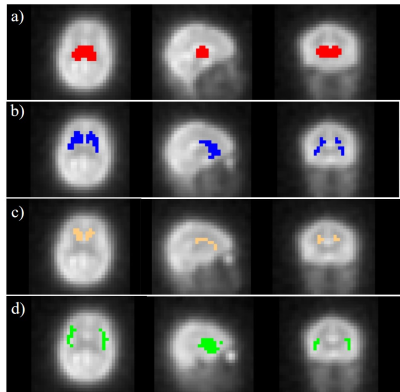 |
Measuring CMRO2 in Brain Subcortical Structures Using Dynamic 17O-MRI
Hao Song1, Burak Akin1, Johannes Fischer1, Ali Caglar Özen1,2, Stefan Schumann3, and Michael Bock1,2
1Dept. of Radiology, Medical Physics, Medical Center University of Freiburg, Faculty of Medicine, University of Freiburg, Freiburg, Germany, 2German Consortium for Translational Cancer Research (DKTK), Partner Site Freiburg, Freiburg, Germany, 3Dept. of Anesthesiology and Critical Care, Medical Center University of Freiburg, Faculty of Medicine, University of Freiburg, Freiburg, Germany
Dynamic 17O-MRI with inhalation of isotope-enriched 17O2 is capable of directly quantifying the cerebral metabolic rate of oxygen consumption (CMRO2). In this work, we investigated oxygen metabolism in brain subcortical structures including thalamus, dorsal striatum, caudate nucleus and insula cortex. The determined CMRO2 values in these areas were compared with literature values obtained by PET studies. Our results show the feasibility of measuring local CMRO2 in brain subcortical structures using 17O-MRI at 3T.
|
|||
1797.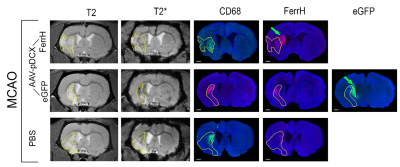 |
MRI visualization of neurogenesis with ferritin and eGFP gene reporters in the intact and post-ischemic rat brain
Marina Y Khodanovich1, Andrey E Akulov2, Tatyana V Anan’ina1, Elena P Krutenkova1, and Anna V Naumova3
1Research Institute of Biology and Biophysics, Tomsk State University, Tomsk, Russian Federation, 2Institute of Cytology and Genetics, Novosibirsk, Russian Federation, 3Radiology, University of Washington, Seattle, WA, United States
The present work demonstrates feasibility of longitudinal visualization of neurogenesis in vivo with MRI gene reporter ferritin and fluorescent reporter eGFP expressed under the doublecortin promoter. Main source of the signal hypointensity in the brain neurogenic zones were mature and young neurons. Main source of the signal hypointensity in the ischemic lesion area were macrophages.
|
|||
1798.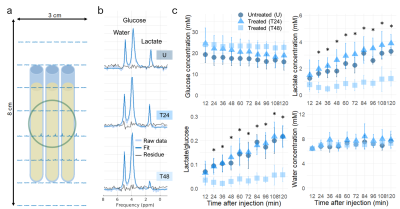 |
Treatment-induced changes in 2H-labeled lactate measured by 2H magnetic resonance spectroscopy are associated with apoptotic cell death
Josephine L Tan1,2, Daniel Djayakarsana1,2, Hanzhi Wang1,2, Rachel W Chan2, Colleen Bailey1,2, and Angus Z Lau1,2
1Medical Biophysics, University of Toronto, Toronto, ON, Canada, 2Physical Sciences, Sunnybrook Research Institute, Toronto, ON, Canada
Elevated lactate production, a key characteristic of the aberrant tumour metabolism, can be detected non-invasively by deuterium (2H) magnetic resonance spectroscopy (MRS). To determine if 2H-labeled lactate measured by 2H MRS can serve as an early marker of tumour response, we investigate the association of treatment-induced signal changes in 2H-lactate in vitro with apoptotic cell death. We show that significantly lower 2H-lactate in 48-hour cisplatin treated cells (1.6 ± 0.4 mM) compared to those untreated (3.2 ± 0.4 mM) and 24-hour treated cells (4.0 ± 0.6 mM) is associated with with an increase in apoptotic area fraction.
|
|||
1799.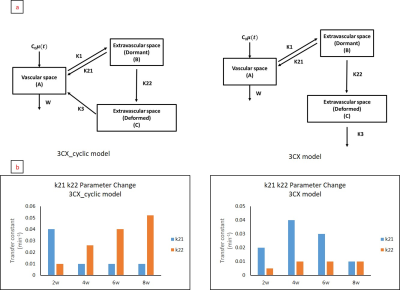 |
Three-compartment modeling for dynamic theragnostic agent enhanced MRI for Quantitative Analysis of NASH progression
Asaduddin Muhammad1, Wonsik Jung2, Sangyong Jon2, and Sung-Hong Park1
1Bio and Brain Engineering, Korea Advanced Institute of Science and Technology, Daejeon, Korea, Republic of, 2Biological science, Korea Advanced Institute of Science and Technology, Daejeon, Korea, Republic of
Non-Alcoholic steatohepatitis (NASH) is a liver condition that has been linked heavily as a precursor to irreversible cirrhosis condition. The symptoms are often silent or non-specific to NASH, causing diagnosis to be difficult. Emerging works in theragnostics have open a chance to diagnose NASH using MRI systems. In this study, we present a three-compartment model that is sensitive to NASH progression. A kinetic parameter derived from the model linearly increased as NASH disease progressed. This study revealed possibility of using contrast agent and compartment modeling to quantitatively analyze the NASH progression.
|
|||
1800.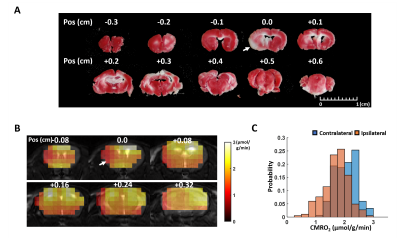 |
Dynamic Oxygen-17 MRI with Model-Based Approach for Mapping Cerebral Metabolic Rate of Oxygen in Mouse Brain at 9.4 T
Yuning Gu1, Huiyun Gao2, Kihwan Kim1, Yunmei Wang2, and Xin Yu1,3
1Biomedical Engineering, Case Western Reserve University, Cleveland, OH, United States, 2Medicine, Case Western Reserve University, Cleveland, OH, United States, 3Radiology, Case Western Reserve University, Cleveland, OH, United States
An oxygen-17 (17O) MRI method combining 3D golden-means-based radial sampling with model-based parameter mapping was developed for non-invasive measurement of cerebral metabolic rate of oxygen (CMRO2) after inhalation of 17O-oxygen (17O2). The method enabled quantification of CMRO2 in post-stroke mouse brain with a nominal isotropic spatial resolution of 1.6 mm. CMRO2 was 1.5 to 2.5 μmol/g/min in the normal tissue, and was ~1 μmol/g/min in the infarct region.
|
|||
1801.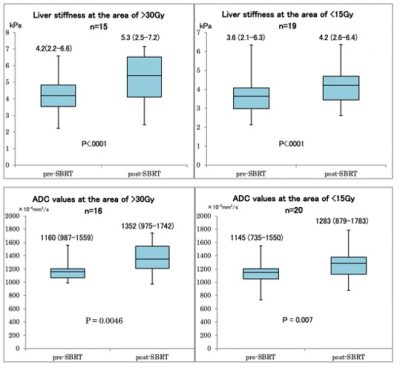 |
Liver parenchymal change after stereotactic radiotherapy for hepatocellular carcinoma using DWI and MRE
Yoshie Omiya1, Utaroh Motosugi2, Hiroyuki Morisaka1, and Hiroshi Onishi1
1University of Yamanashi, Yamanashi, Japan, 2Kofu-Kyoritsu Hospital, Yamanashi, Japan
Stereotactic body radiotherapy (SBRT) is a treatment option for patients with hepatocellular carcinoma (HCC). It has been difficult to know radiation induced liver damage by SBRT using conventional imaging modalities. In this study, we evaluated the liver parenchymal changes after SBRT using two quantitative MR imaging; stiffness measurement with MR Elastography(MRE) and the apparent diffusion coefficient (ADC) values with DWI.Liver stiffness and ADC values were significantly elevated in both the liver parenchymal areas receiving large radiation dose (>30Gy) and small radiation dose(<15Gy). Liver stiffness and ADC values might be able to catch the substantial liver parenchymal changes after SBRT.
|
|||
1802.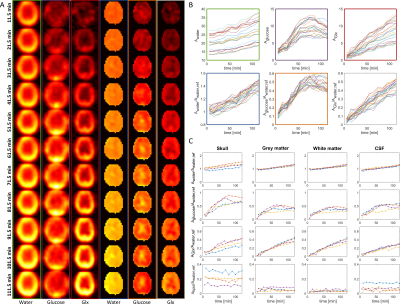 |
Deuterium Metabolic Imaging of the human brain at 9.4 T: Coil design and dynamic glucose uptake
Loreen Ruhm1,2, Nikolai Avdievitch1, Theresia Ziegs1,2, Armin M. Nagel3,4, Henk M. De Feyter5, Robin A. de Graaf5, and Anke Henning1,6
1High-Field MR Center, Max Planck Institute for Biological Cybernetics, Tuebingen, Germany, 2IMPRS for Cognitive and Systems Neuroscience, Eberhard-Karls University, Tuebingen, Germany, 3Institute of Radiology, University Hospital Erlangen, Erlangen, Germany, 4Division of Medical Physics in Radiology, German Cancer Research Center (DKFZ), Heidelberg, Germany, 5Radiology and Biomedical Imaging, Yale University, New Haven, CT, United States, 6Advanced Imaging Research Center, UT Southwestern Medical Center, Dallas, TX, United States
DMI (Deuterium Metabolic Imaging) is a technique that enables the investigation of metabolic turnover rates along predefined pathways non-invasively. In this work, we present first DMI data from the human brain at B0 = 9.4T and an investigation of the dynamic glucose uptake in different areas of the human head for healthy volunteers and after the oral administration of [6,6’-2H]-glucose. We present a dedicated phased array coil design and 2H MRSI data with high spatial resolution for water, glucose, Glx and lipid/lactate. Finally, we compare the uptake curves for different regions in the human head.
|
|||
1803.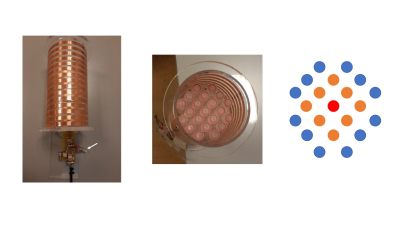 |
Low field 19F imaging of perfluoroctylbromide: eliminating chemical shift effects and minimizing scalar coupling signal loss
Javad Parsa1 and Andrew Webb1
1Leiden University Medical Center, Leiden, Netherlands
Phantom 19F images have been obtained from perflurooctylbromide (PFOB) at very low magnetic field (2.15 MHz). The small spectral dispersion (in Hz) means that all fluorine nuclei contribute to the signal without chemical shift artifacts or the need for specialized sequences. Long turbo spin echo trains with short interpulse intervals and full 180o refocussing pulses suppress scalar coupling, leading to long apparent T2 values and highly efficient data collection. Overall, the detection efficiency of PFOB is actually higher than that of tissue protons at very low field.
|
The International Society for Magnetic Resonance in Medicine is accredited by the Accreditation Council for Continuing Medical Education to provide continuing medical education for physicians.